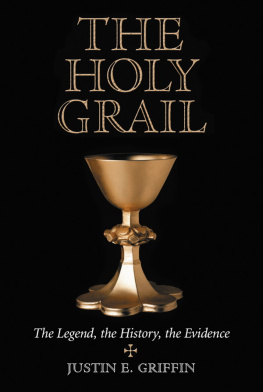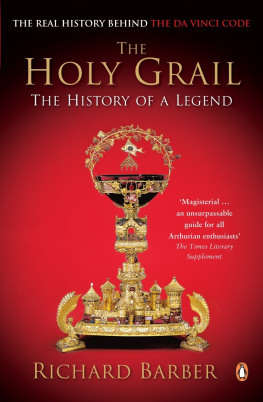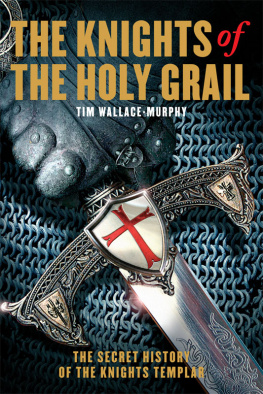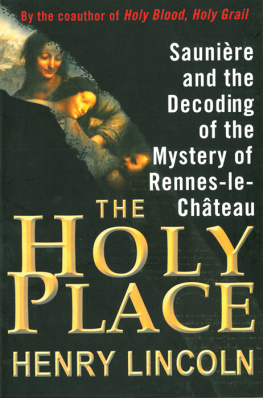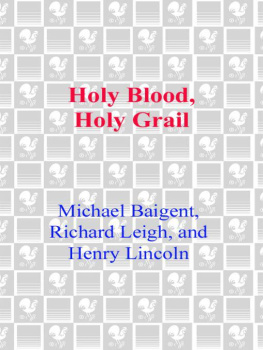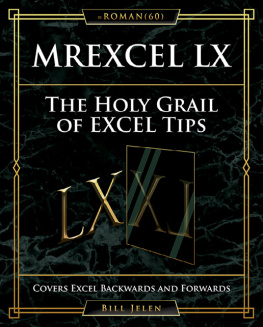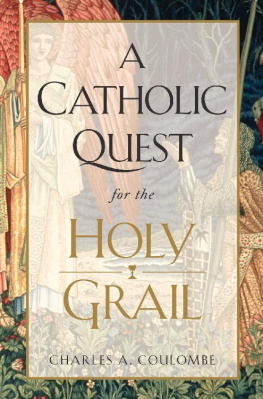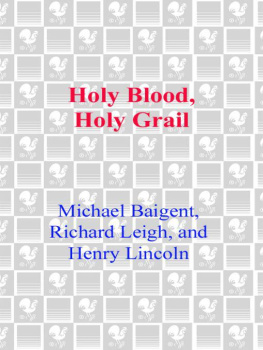
Table of Contents
Library of Congress Cataloguing-in-Publication Data
Griffin, Justin E.
The Holy Grail : the legend, the history, the evidence / by
Justin E. Griffin.
p. cm.
Includes bibliographical references and index.
ISBN 0-7864-0999-1
1. GrailLegendsHistory and criticism. 2. Grail. I. Title.
PN686.G7G75 2001
398'.35dc21 2001031219
British Library cataloguing data are available
2001 Justin E. Griffin. All rights reserved
No part of this book may be reproduced or transmitted in any form or by any means, electronic or mechanical, including photocopying or recording, or by any information storage and retrieval system, without permission in writing from the publisher.
Cover image 2001 PhotoSpin
McFarland & Company, Inc., Publishers
Box 611, Jefferson, North Carolina 28640
www.mcfarlandpub.com
To my wife, Donna Griffin,
whose love, dedication, encouragement, and
perseverance made this book come to fruition.
Also to my mother, Peggy Griffin,
with love and thanks.
ACKNOWLEDGMENTS
When I began researching the Grail legend about six years ago, I had no idea where it would lead me or what I was about to get myself into. I just started reading.
Once I felt I had enough knowledge to begin discussing the legend, I began an Internet web site and discussion group about my thoughts and findings. This allowed me the opportunity to speak with a widely diverse group of people from all around the globe. As it turned out, having access to their knowledge and theories made all the difference.
I would like to thank all the people who contributed to the making of this book. First among them are the members, past and present, of the e-mail discussion group, the Grail Group. Among these, special thanks go out to John Koopmans, who contributed many of the pictures contained in this book, and Juan C. Gorostizaga, a good brother of the Cofrada del Santo Cliz de Valencia, who introduced the Santo Cliz and its history to me. A special thanks to Mr. Fernando Parrado of the University of Tennessee, Knoxville, who helped me translate the book Juan sent to me about the Santo Cliz. My thanks also to Claudia Ldtke, who took several pictures of the chapel of the Volto Santo in Lucca, Italy, and to Francis Thye, who contributed the picture of Saint Josephs Well, as well as all the good people at Glastonbury Abbey who have been so helpful during my research.
Finally, my thanks to all those friends and family members who have had to read several iterations of this text before it was completed. Thank you Donna, Janet, Tim Watson, Ann Lacava, and Dr. Laura Howes.
PREFACE
Why would someone choose to study a subject like the legend of the Holy Grail? Why not study some other, more tangible historical object or event? Why waste time trying to prove what must surely be a mere myth?
To me, the greatest part of the human character is the desire to know. This means not only knowing things that can be useful in everyday life, but also knowing things just for the sake of knowing. Humans have a capacity to look beyond the obvious and delve into questions that, while serving no physical purpose, tempt the mind to expand a bitgrow beyond the knowledge of science, government, and economics. Mysteries such as the Grail make mans walk through life interesting.
My interest in researching the Grail, along with other legends of early Christianity, began in 1993. I had always been interested in the legends of King Arthur and medieval history in general; then, my interest in ancient religious artifacts was piqued by a documentary discussing the historical evidence surrounding the Ark of the Covenant. The two interests combined led to one intriguing legend: that of the Holy Grail.
It astounded me that archeologists and other researchers had ever seriously pursued what I had thought was just myth and story. This made me wonder what hidden chambers and lost pathways might be found if I, too, investigated the texts and histories associated with the Grail legend. Thus began my own quest. Since I worked at a university library at the time, I had what I thought was a limitless supply of reference material with which I might feed my curiosity. However, I soon exhausted the resources at hand and began looking elsewhere for information. As I drew from sources made available to me though interlibrary loan, my notebooks filled a little more.
It was not until I began to tap the vast world of the Internet, and the contacts made via my Grail Legend website and discussion group, that I began to make any real, measurable advancement. Being exposed to literally a world full of other legends and histories allowed me to see the Grail legend in a whole new light. I began to believe it possible that a historical Grail may exist.
However, this new world of information presented problems. I soon found that there was so much information about the Grail, and that so much of it was contradictory, that it would be quite difficult to determine what information could be true and what false.
As luck would have it, this very conundrum would lead me to an important realization. In the midst of a sea of confusion, contradictory accounts of separate objects and histories, all having what seemed to be a valid claim to the title of THE Holy Grail, I found that I had been looking at the problem all wrong.
Just as the Grail hero Perceval needed to ask the right question at the right time, I realized that I had been over-instructed on how to deal with the Grail. I needed to approach the mystery in bare ignorance, not clothed in the armor of preconceived notions. I realized that the only way to understand the Grail and its legend was to unlearn all I already thought I knew about the subject, and simply follow where the facts led. By this method, I discovered a path through the tangle of information. This book retraces that path.
The book outlines the basics of the Grail legend, investigates the historical aspects of events that led to the legend, and, finally, examines the legitimacy of the claims made by several contenders for the Holy Grail, concluding with a new theory about the mysterious artifact. Subjects covered in this book include the main body of the Grail legend, including the story of the life of Christ and His crucifixion, the secondary histories and legends associated with those who played a part in His burial, the medieval search for the Grail and other relics of the Passion, and the historical references pointing back to the Grail that have been hidden in time and lost in apathy.
The Grail legend is one of the best known stories to survive the Middle Ages, but it is also possibly the least understood. Most treatises dealing with the Grail incorrectly relegate it to the realm of Celtic folklore, Christianized to suit the proper audience, or else treat the Grail as a simple idea to be approached as a mere psychological or spiritual study. Few investigations deal with the Grail as an historical object, as real as a pot shard or the ruins of a city.
It is my hope that this book will lead its readers to the understanding that the truth is sometimes much stranger than fiction. Sometimes, the things we dismiss as common knowledge may reveal, on closer examination, elements of mystery and surprise.
1
BIBLICAL ORIGINS OF THE GRAIL
Before beginning a discussion about the existence or nonexistence of the Holy Grail, it is first necessary to speak about the nature of myth and legend. When someone uses the word legend, what is truly being said? The word holds a peculiar place in our vernacular. It is simultaneously fact and fiction, truth and fantasy. It cannot be dismissed as an utter fabrication, because the word contains a hint of truth. Nor can it be completely accepted as historical fact, because the word suggests an element of fantasy. Therefore, a researcher investigating a historical legend such as the Grail is in a peculiar position. The available information is usually less than reliable, and often there is so little information, reliable or not, that nothing new can be discovered.
Next page
